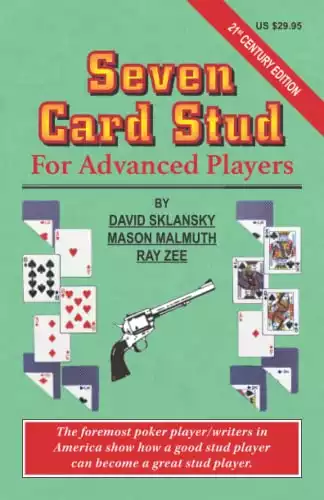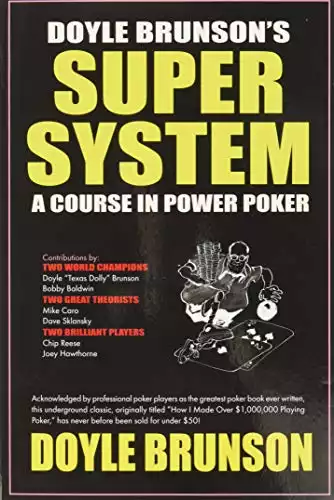Rules of the Game
Seven Card Stud is an American classic but many players entering poker post Moneymaker boom may not have been exposed to the game. Every player antes and then “3rd street “is dealt with two cards down and a “door card” face up. The player with the lowest card is then forced to bring in another bet and the action continues with the player to the immediate left of this “bring-in”. This player has the option to fold, call the bring-in or “complete” the bet to the lower betting limit. For example, in a typical $20/$40 game everyone antes $3, the forced bring is $5, and completing the bet would be $20. As the action moves around the table, players may raise a completion with the usual maximum for the round being four raises or in this case $80.
On the successive betting rounds the highest ranked hand acts first and the action continues around the table clockwise. The fourth, fifth, and sixth street cards are dealt face up while seventh is dealt down. When compared with flop and draw games, stud games have an extra betting round.
The popularity of Seven Card Stud took a huge hit as a result of the Hold’em boom; however, the games in Atlantic City and Foxwoods are still plentiful and action filled. In addition, Stud is a component of HORSE and other mixed game tournaments throughout the country so it is certainly a game worth learning. Stud is a great game for observant players due to the fact that folded board cards can drastically impact hand values. This along with the extra betting round makes it a great game for skillful players to extract money from weaker ones.
Basic Strategy
Most of the hands you will get involved with are the big pairs and the best strategy is usually to play them in a straightforward fashion and simply keep betting until the boards or action makes it appear as if you may not have the best hand.. It does not pay to get tricky with these hands; a pair of aces would be lucky to survive a multi-way pot but it can easily make a lot of money against one obstinate opponent chasing with a lower pair.
It is important to be exercise proper hand selection on 3rd street because mistakes made there can easily lead to more costly ones as the hand develops. The most common leak of most players is that they constantly put themselves in situations where they are improperly chasing a higher pair. When a tight player completes in early position with an ace up it is best to simply fold the vast majority of your pairs. The only paired hands really worth playing in this situation would be hands like (J♣T♥)J♥ or (6♣6♦)7♣ where you have a straight flush kicker with the latter hand having the additional benefit of the pair being in the hole. The implied odds here are greater as you can make very well disguised trips. However, you do not automatically go the end with these ends. The situation needs to be re-evaluated on 5th street.
Pairs without straight flush kickers should be folded; even those as good as (Q♣5♥)Q♠. This takes extreme discipline (especially when you been card dead for a while) but keep in mind we are talking about a straightforward player from early position. If your opponent has aces, he has both the best hand and the best draw and since your opponent’s kicker is hidden you will not know if or when he makes two pair. The situation would be dramatically different if you instead held the (Q♣A♥)Q♠ and were facing a raise from a king up card; here you would definitely play as long as your cards were mostly live.
In general if there is a high likelihood that you are up against a big pair you require either a straight/flush kicker or one that is higher than your opponent’s pair. See the advanced articles for detailed guidance on how to play these types of hands.
When you are playing drawing hands such as the three flushes and straights it is imperative that your cards are live. If you improve your draw on 4th street you will usually continue on for the remainder to the hand but there are some situations where you need to fold. One clear example is when a player you have pegged for probably having a pair of aces hits another ace on 4th street. When your opponent has trips he has both the best hand and the best draw and since it is still relatively early in the hand it is time to go out.
When starting out in Stud, focus on the following principles and you will more than hold your own as you learn the nuances of the game:
- Play live hands (i.e. The cards that will improve your hand are not on the board)
- Start with the best hand
- If you don’t have the best hand you should believe you have the best draw
Discussion on Starting Hands Types
- Rolled Up Trips – You will be dealt this monster every 424 hands and while the urge to slow play them is strong you should tend to play your hand fast the majority of the time. When you hold low trips someone could very easily pair their door card and take the lead in the hand. Also players will often put you on a high pair in the hole so if they later pair their board that isn’t a higher door card you can often get additional action later hand. With high trips it’s typically optimal to play it the same as you would if you just had the big pair. You usually get action anyway, and may actually arouse suspicion if you are an aggressive player and are playing a high card meekly.
- Three High Cards to a Straight Flush – Hands like (A♠K♠)Q♠ and (Q♥J♥)T♥ are premium holdings because they can make big flushes, straights, and high pairs. They should often be played strongly both to get more money into the pot and if you limit the field you have a greater chance to win with a large pair in the event that your flush and straight draws do not pan out. Just pile in the money and see how many players come along, these hands play well both shorthanded and multi-way.
- Big Pairs – Tens through Aces are usually what players refer to as the big pairs but in Stud hand values are always relative. On boards with many high cards a pair of tens may not be worth much while on other boards a pair of eights has a good chance of being the best pair. Big pairs are the bread and butter hands in Stud; they are the hands you will be playing and going to the end with most often.
- Three Flushes – These can range from super premium such as the (A♠K♠)Q♠ with live cards to money losing holdings such as a (7♦3♦)2♦ with four other diamonds out on the board. When deciding whether or not to play a flush draw the following should be considered:
- Is your suit live? With two or more of your suit out your holding typically needs to hold other value to be worth playing.
- Do you have high cards that if paired would probably beat another player’s probable pair? For example an AK9 with live aces and kings but with three hearts out is playable versus an opponent with a queen up.
- Are your cards connected? Straight outs to go along with a three flush can add much value.
- Do you have a good chance to steal the antes? A weaker flush draw can be played if there is a reasonable chance that you can win the pot uncontested.
- Three Straights – Similar to flush draws these holdings range from very strong to easily foldable. A three straight is strongest when there are no gaps but there are other considerations:
- Are he straight cards are live? For example if you hold (78)9 it is mostly important to notice how many tens and sixes are out on board but also take notice of the fives and jacks.
- Once again the presence of high cards that if paired may trump another player’s probable pair. If you hold (TJ)Q you have an easy re-raise against a player who completed with a seven up. If the seven simply called the bring-in you should almost always complete the bet yourself.
- A two flush adds much value to your holding especially in a multi-way pot
- Straight draws lose a lot of value when the pot is being contested by five or more players; even if you are able to complete your draw there is a greater chance of looking at a flush or full house at the end of the hand.
- As usual if there is a reasonable chance that you may be able to successfully steal the antes it is acceptable to complete the bet with a less than stellar holding.
- Small and Medium Pairs – Usually considered to be 22-99 but as previously discussed hand values are relative in Stud. In practice it is a pair that is probably not the best one out on 3rd street but is being played for at least one (and preferable more than one) of the following reasons:
- Your cards are live
- Big kicker that is larger than the pair your opponent is representing
- Straight flush kicker e.g (6♥7♣)7♥
- Pair is in the hole which would give you hidden trips and implied odds
- Three Big Cards – Holdings such as 9QA are typically reserved for ante stealing but they can also be used to challenge tight aggressive players raising in a steal position or attacking a limper.
Further Learning
Seven Card Stud For Advanced Players by Mason Malmuth, David Sklansky, and Ray Zee (Rating 9/10) – This is a tremendous book and resource on Seven Card Stud. It was written many years ago but still highly relevant to the $75/$150 and under games that are played on the East Coast today. In particular the lengthy discussion on 3rd street play is outstanding. The only thing this book lacks is mathematics and simulations that back up some of their conclusions.
Super System I by Doyle Brunson (Rating 8/10) – Doyle and his expert collaborator, Chip Reese wrote a very insightful chapter in the original “Poker Bible”. The only real criticism is that is not very long.
Next: Playing Small Pairs with Big Kickers in Seven Card Stud->


